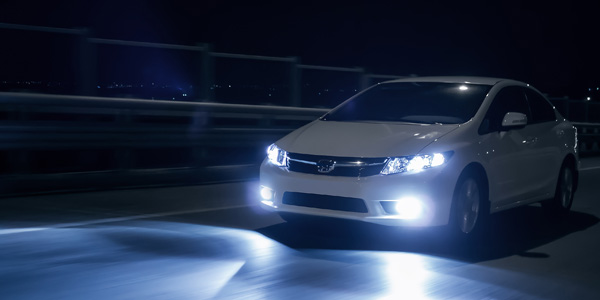
It’s no secret that the growing use of LED lighting in new vehicles will eventually have a major impact on the sale of aftermarket replacement headlamps and taillamps as time moves on. LEDs are extremely long-lasting, some say maybe even “lifetime” lamps that may outlast the vehicle itself. Even so, the vast majority of cars and trucks that are currently on the road have conventional halogen or incandescent headlamps, taillamps and small bulbs that have a limited lifespan.
The average standard halogen headlamp lasts about 450 to 500 hours. Heat, light output (both of which are a function of bulb wattage) and the materials used in the construction of the bulb determine how long the bulb will last before it burns out, or dims to the point where light output is noticeably reduced (yes, bulbs do dim over time due to a buildup of black tungsten filament particles on the inside of the bulb).
The more night driving a motorist does, the faster their headlamps age. Shorter daylight hours during the winter months means many people are commuting to and from work in the dark. Driving with the headlights on during rainy or stormy weather also uses up bulb life.
Vehicles with daytime headlamps that remain on all the time to improve safety and visibility to other motorists typically reduce the voltage to the headlamps to extend bulb life. Even so, after four or five years of driving, the headlamps on many vehicles start to fail and need to be replaced.
If one headlamp has burned out, the other is probably near the end of its service life too, so always recommend replacing BOTH bulbs at the same time.
Taillamps typically last much longer because they don’t work as hard as headlamps (less wattage, light output and heat). LED front- and rear-facing lamps usually don’t fail at all unless something goes wrong with the lighting module or wiring that supplies them with power.
When a customer needs a replacement headlamp, taillamp, turn signal, brake, side marker or interior bulb, make sure they get the correct replacement bulb that has the same socket configuration, voltage and wattage rating as the original. The wrong bulb may not fit at all, or it may fail or cause problems with a lighting control module.
Headlamps: Much More Complex Than People Realize
Headlamps are much more complex than many people realize. The exact placement of the bulb inside a composite headlight housing affects the optics of the system and where the beam is projected on the road ahead. A bulb that is too short or too long will alter the focus of the headlights, resulting in a beam pattern that may be too wide, too narrow, too high, too low or too short for safe driving.
Most bulb suppliers offer a range of upgrade options for standard halogen headlamps and older sealed beam headlamps. Upgrades include bulbs that appear to be whiter and/or brighter than standard halogen bulbs (30 to 60 percent brighter), or bluer to mimic a HID headlamp system. There also are bulbs with extended life (2X to 4X longer) for applications with hard-to-replace headlamps (some require a lot of disassembly).
Color ratings can be confusing and misleading because yellow/white light (2,700 to 3,300 K) actually penetrates fog, rain and mist better than whiter (3,500+ K) or bluer (4,200+ K) light. Many people don’t like the bluish light produced by many HID headlights in oncoming vehicles because of the glare it creates. However, whiter/bluer light does improve illumination and extend night vision under clear weather conditions.
For street-driven vehicles, DOT rules limit maximum light output for low beams (700 lumens) and high beams (1,200 to 1,300 lumens). Headlamps marked “DOT” are “DOT compliant” and street-legal in all 50 states. Headlamps that are not DOT compliant because of higher-than-allowed brightness are NOT legal for highway use (although many people ignore the rules and install super-bright offroad lights anyway). Many states also have rules that only allow white or yellow headlamps, fog lights or trim lights and forbid the use of other colors such as red, blue, green or purple because those colors are for emergency vehicles only.












